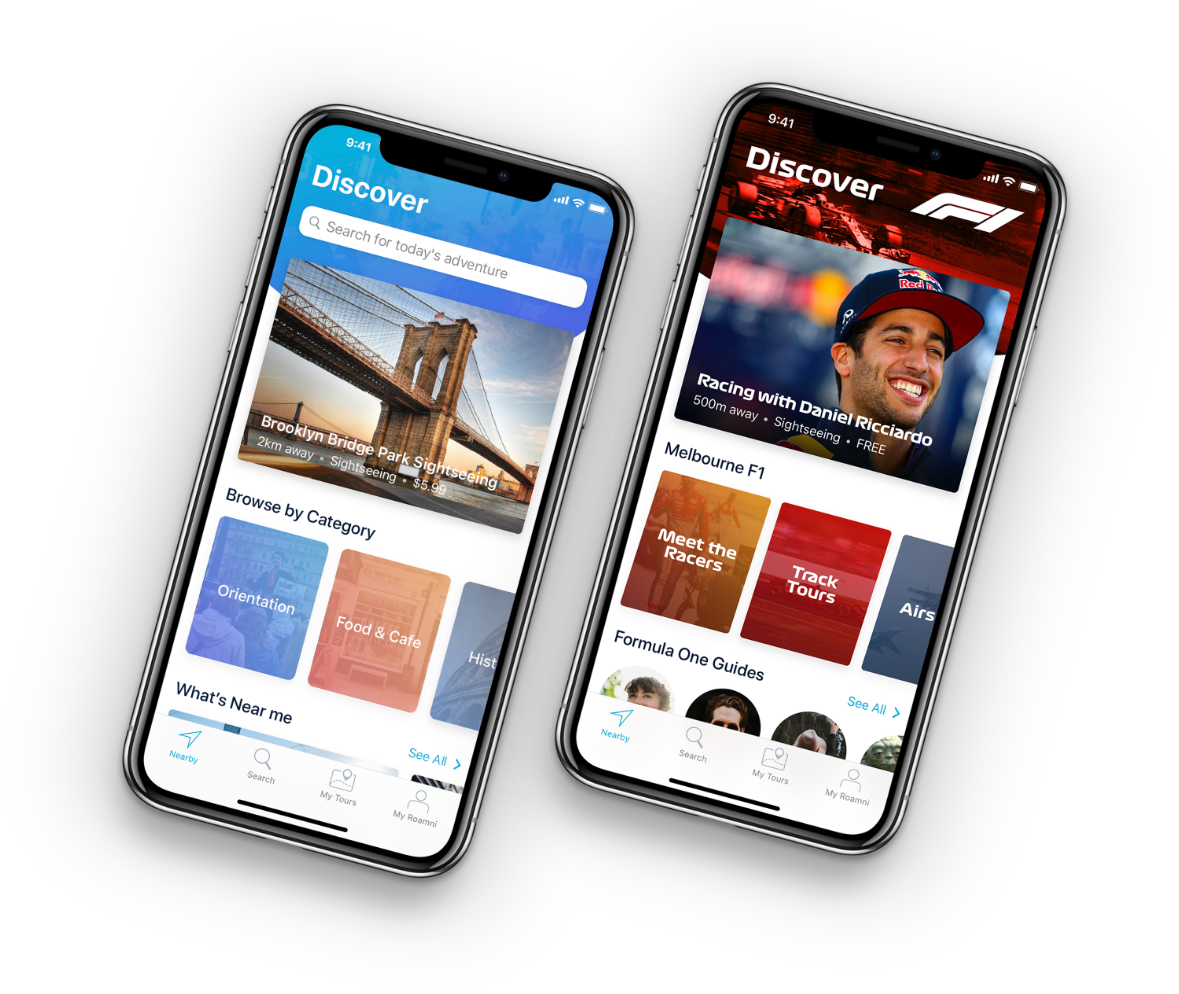How to Patent an App Idea in 2025 (Is It Even Possible?)
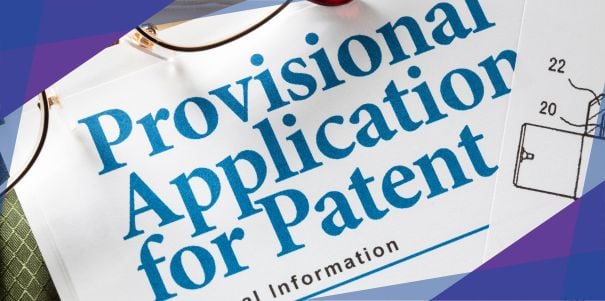
Have you ever come up with an app idea so groundbreaking that you couldn’t stop thinking about it?
You picture it solving real-world problems, making life easier, or even disrupting an industry. But then the big question hits: How can I make sure no one steals this app idea? Is this even possible?
We’ve spoken to hundreds of entrepreneurs, app developers, and companies who have had similar thoughts cross their minds while dreaming up the next revolutionary invention.
But, what many don’t realize is that without taking the proper steps to protect your creative vision, those hopes of stardom can quickly turn into lost dreams.
So, if you have a mobile app idea and want to know if you can patent it, if it does even matter, and if it is even worth it, and what happens after the patent application is filed, carry on.
Unpacking the steps on how to patent an app idea
- Figure out if your app idea qualifies to be patented
- Decide if you should really patent your app idea
- Do a patent search to make sure your idea is unique
- File a provisional patent application as your “placeholder” for protection
- File a full patent application (The Real Deal)
- Bonus: What are the other alternatives to patenting an app?
1. Figure out if your app idea qualifies to be patented
Not every mobile app patent is created equal. The patent office—whether it’s the United States Patent and Trademark Office or another regional patent office—looks for three things: novelty, non-obviousness, and utility.
If your mobile app brings something new and non-obvious, and has a real-world use, you might be eligible for patent rights. These entities have some pretty specific criteria your app needs to meet.
Let me break this down into bite-sized pieces:
Does your app pass these three must-have tests?
1. Is it truly NEW?
Your app idea needs to bring something fresh to the table that hasn’t been patented. Think about how Uber revolutionized transportation with their matching algorithm—that was genuinely novel. Ask yourself: “Has anyone else already created what I’m thinking of?” If the answer is yes (even partially), you might need to pivot.
2. Is it NON-OBVIOUS?
This is where many app ideas stumble. Your innovation can’t just be a logical next step that any app developer would naturally think of. The USPTO looks at whether a “person having ordinary skill in the art” would find your solution surprising or unexpected. If you’re just adding a dark mode to an existing app concept, it’s probably not “patent material”.
3. Does it solve a REAL problem?
Your app must have practical value—it needs to actually do something useful in the real world. This is what the USPTO calls “utility” or “industrial applicability.” A game might be fun, but does it solve a genuine problem or serve a functional purpose?
These three questions got you thinking, right? But wait, there’s more.
Why patenting software isn’t the same everywhere
Let’s get real for a second—just because you can patent an app in one country doesn’t mean you’ll get the same green light everywhere. Europe, in particular, plays by its own rulebook.
Here’s the deal:
- In the US and Australia, you can patent software if it’s new, non-obvious, and solves a real problem.
- But in Europe, you need to jump through extra hoops. The European Patent Office (EPO) won’t grant a patent for “software as such.” Translation: if your app is just a clever bit of code or a business method, it’s a no-go.
- To get a patent in Europe, your app must deliver a technical solution to a technical problem. Think: controlling a robot arm, improving data security, or boosting how a computer works—not just making life easier for users.
So, in reality, if your app’s magic is all about algorithms or user experience, Europe might say “thanks, but no thanks.” But if you’re solving a hardcore technical challenge, you’ve got a shot.
Here’s a short video by Patent Professor, an expert in patent law, discussing the difference between the two.
Patenting an app idea works similarly to patenting any other type of invention. The mobile apps’ functionalities and designs must be unique and non-obvious. This way, opportunists and rippers will find them difficult to replicate.
Now, let’s move on to the next section, where it’s up to you to decide whether patenting an app idea is worth it.
2. Decide if you should really patent your app idea
Before jumping into the patent process, take a moment to ask yourself: Is patenting my app idea the right move?
Patent services can be pricey, and the journey from patent application filed to patent granted can take years. Sometimes, focusing on building and launching your app quickly is the smarter move.
While patents offer legal protection, they’re not always the best option for every app or entrepreneur.
Let’s break down the reasons.
Why patenting might not be practical
Patenting an app can be costly and time-consuming.. Here are some key challenges to consider:
- High costs. The upfront expenses for filing a patent can range from $5,000 to $20,000, depending on complexity and geographical scope. For startups and small businesses, this money might be better spent on product development, app marketing, or building brand awareness.
- Lengthy process. Patents typically take 18–24 months to get approved and can stretch to three years for complex applications. This delay could slow down your plans to launch your app and gain traction in the market.
- Limited protection. Even with a patent, enforcement can be tricky. Competitors may create slightly modified versions of your app that bypass your patent claims. Litigation for infringement is costly and lengthy.
Every region may have slightly different eligibility requirements and nuances in its patent law.
If you need to file patents in multiple countries, you may also check the Patent Cooperation Treaty (PCT)’s guidelines.
The Patent Cooperation Treaty (PCT) is like a global passport for patents. It’s an agreement that makes it easier for inventors (or companies or app developers in our context) to file a single application to protect their inventions in multiple countries.
This means you can apply for a patent in over 150 countries at once, instead of having to do it separately in each country. While the PCT doesn’t grant patents directly, it streamlines the international patent application process.
Think of the Patent Cooperation Treaty (PCT) as a way to save time and money on patent examinations.
With the PCT system, you can submit one application that’s valid in multiple countries.
Here’s an introduction video of how PCT works
This doesn’t automatically get you a patent; instead, your application goes through an initial assessment to check if your invention qualifies. This step helps you get feedback and can delay patent examination costs of individual country patent reviews.
Once you’ve made an informed decision about whether to patent your app idea or pursue other options, it’s time to move on with the next step: conducting a thorough patent search.
3. Do a patent search to make sure your idea is unique
So, you’ve decided to move forward with protecting your app idea. Great.
But before you get too excited, there’s an important step you can’t skip: checking if someone else has already patented something similar. This is called a patent search, and it’s your way of confirming that your idea is truly one-of-a-kind.
A thorough patent search process is a must to help prevent a patent breach lawsuit later. Use patent databases to check for existing patents or prior art that might block your path.
Tools you can use for patenting an app idea
Here are some handy resources to get started with your search:
- Google Patents. A user-friendly tool that allows you to search for patents worldwide.
- USPTO Patent Search. The official U.S. database for patents and published applications.
- IP Australia Patent Search. Ideal if you’re targeting the Australian market.
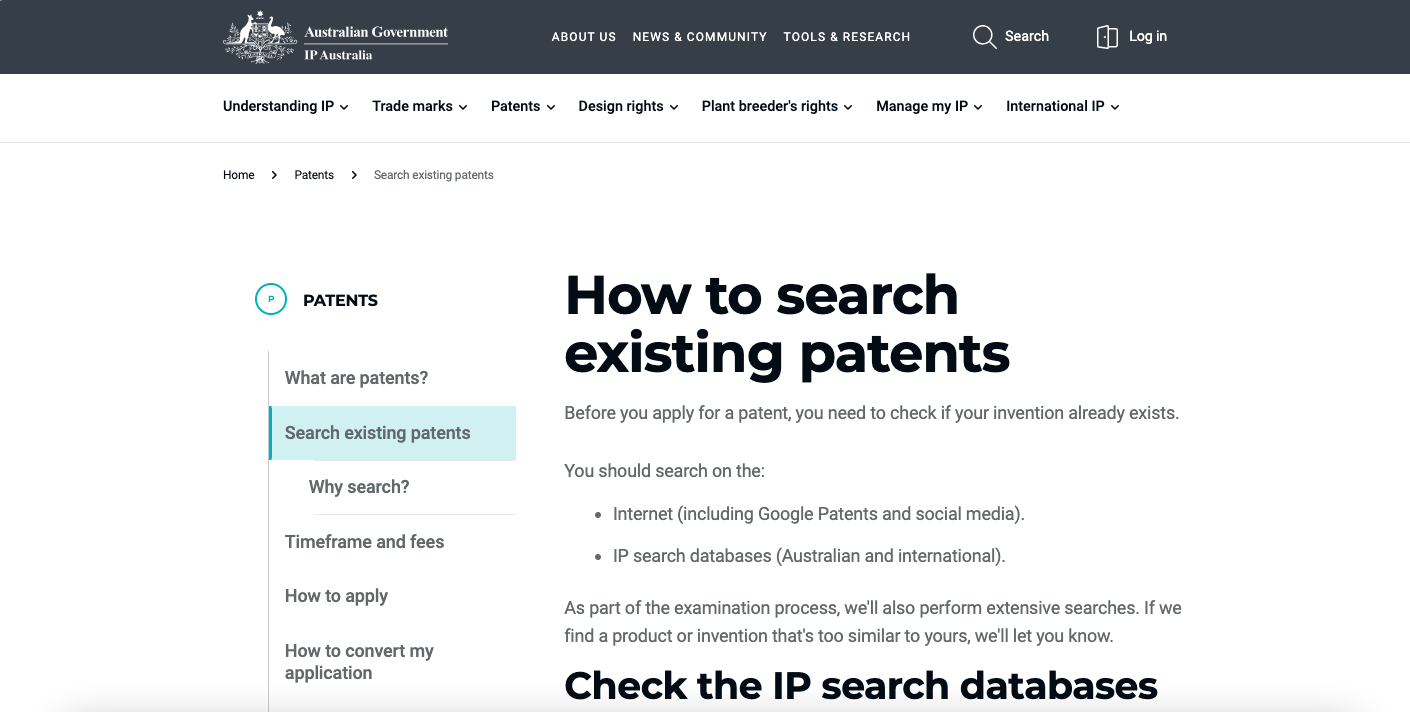
Source: IP Australia
How to approach it
Start by listing keywords that describe your app’s unique product features or functionality. Then, use these tools to search for similar ideas.
For example, if your app uses AI for personalized recommendations, try terms like “AI recommendation system” or “machine learning algorithm.”
A word of caution, though
I won’t sugarcoat it—patent searches can be tedious and tricky. It’s easy to miss something important if you’re unfamiliar with how patents are written (spoiler: they’re not in plain conversational English).
That’s why it’s a good idea to work with a patent attorney or legal expert, especially if you want to avoid any future patent trial. They’ll help ensure your search is thorough and accurate, saving you headaches and money down the road.
4. File a provisional patent application as your “placeholder” for protection
Ready to lock down your app idea? Now let’s talk about provisional patents—the fastest, most affordable way to protect your app invention while you refine it.
Think of this as staking your claim with a “patent pending” badge while you prepare for the full legal marathon.
Why start with a provisional patent?
- Take advantage of its affordability. Filing fees start at just $70 for micro-entities (USPTO Fee Schedule).
- Buy time as you secure your resources. Gives you 12 months to test your app, tweak features, or even secure funding before filing the full patent.
- Prepare for your priority date. Establishes your legal “first in line” status if someone else tries to patent a similar idea later.
How to file a provisional patent application (without losing your mind)
1. Document everything
Write a detailed description of your app—how it works, what problem it solves, and why it’s unique. Include sketches, flowcharts, or screenshots. The more specific, the better.
2. Use the USPTO’s online system
File electronically through the USPTO’s EFS-Web. It’s designed for beginners, with step-by-step instructions.
3. Pay the fee
Depending on your business size, costs will vary, as there are also other additional requirements. Keep the receipt—it’s proof of your filing date.
4. Mark your calendar
You’ve got 12 months to convert this provisional application into a non-provisional one. Miss the deadline, and you lose your priority date.
What happens next after filing?
Once filed, you can legally use “patent pending” on your app—a powerful marketing tool to attract investors or deter copycats. Use the 12-month window to:
- Build your MVP
- Conduct user testing
- Scout for funding
But remember: A provisional patent doesn’t guarantee approval. It’s just the first step.
Need help? If the legal jargon feels overwhelming, hire a patent attorney to review your application. They’ll spot gaps and ensure your description is airtight.
So, should you decide to take the provisional patent application, you can move on to developing your MVP.
Want to see how an MVP mobile app achieves its success even without filing a patent application?
Here’s how Roamni made it from vision to being a partner of F1 Formula and Australian Grand Prix.
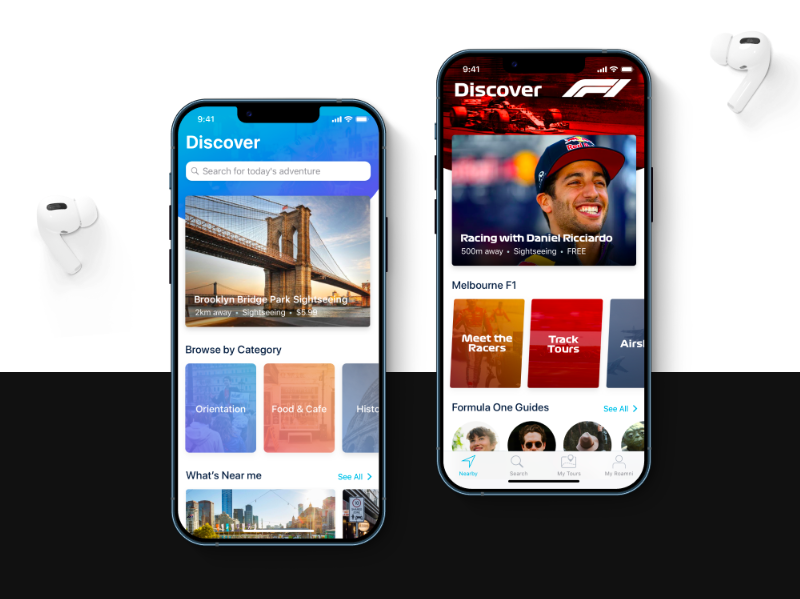
5. File a full patent application (The Real Deal)
So, you’ve got your provisional patent sorted—nice work! Now it’s time to level up with a non-provisional patent application.
This is the official request to the USPTO to grant you a full patent. Let’s break it down without the legal mumbo jumbo.
What you’ll need to file
- Detailed description. Explain every feature of your app—how it works, why it’s unique, and what problem it solves. Think of this as a technical manual for your invention.
- Claims. These define exactly what your patent protects. For example, if your app uses a new algorithm, your claims should spell out that specific process.
- Drawings. Flowcharts, diagrams, or screenshots that show how users interact with your app.
- Oath/Declaration. A signed statement confirming you’re the rightful inventor.
Here’s an example of Facebook’s patent protecting its back-end functionality. Instead of patenting the entire app, the company patented a novel feature. You won’t even notice this whenever you use it.
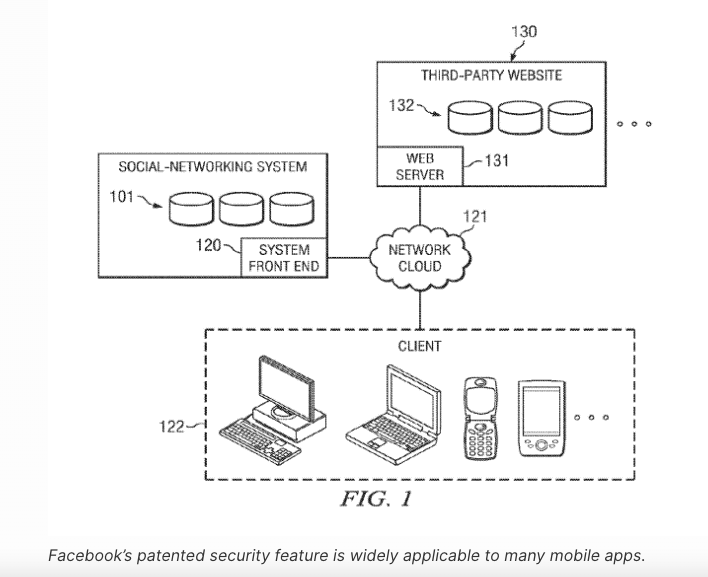
Source: Rapacke Law Group
What happens next?
- Examination phase. A USPTO examiner reviews your application. They’ll check if your app is truly new, non-obvious, and useful.
- Office actions. You might get requests to clarify or adjust claims. Respond promptly—delays can add months to the process.
- Approval timeline. 1–3 years or more (yes, it’s a marathon!)
Post-approval patent maintenance fees
Even after your patent is granted, you’ll need to pay maintenance fees to keep it active.
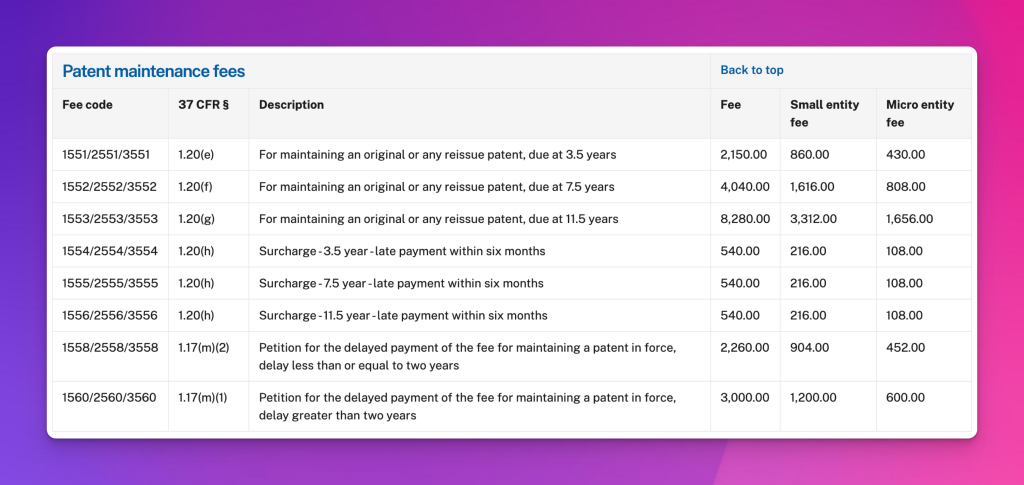
Source: USPTO
Pro Tip: Miss these deadlines, and your patent expires—game over.
Why go through all this patent app filing?
You stop others from copying, selling, or using your app without permission. There’s also the opportunity to earn royalties by letting companies use your patented tech. If you’re dead serious about attracting investors, patents make your startup look legit and scalable.
But then, a boatload of money is needed to have the best of both worlds for costs and credibility.
What are the other alternatives to patenting an app?
Let’s be real—patents aren’t for everyone. They’re like buying a full medieval suit of armor when sometimes a bike helmet will do.
If the patent process feels too slow (2-5 years or more) or pricey ($2,000 – $8,000 upfront?), try these workarounds:
1. The “Zip It” contract with Non Disclosure Agreements (NDAs)
An NDA (non-disclosure agreement) is your first line of defense when sharing your app’s secret sauce. This is perfect for companies working with agencies or freelance hires.
At Appetiser Apps, we collaborate with startup founders and companies in the same or different industries. That’s why we always have an NDA when working on projects, from start to finish.
2. The “Brand Bodyguard” with trademarks
Trademarks lock down your app’s name, logo, or tagline—anything that screams “This is us!” Think Uber’s iconic U logo or Twitter’s bird. What’s in it for you if you push through this route? You can sue copycats, build customer trust, and turn your brand as a pioneer.
But watch out. Costs pile up ($200–$500+ per class) and although you have a protection’s geofenced, you’ll fight forever renewing it. Bottom line: Skip if you’re broke; nail it if you’re building a legacy.
3. The “Code Vault” with copyrights to protect your code and design
Copyright auto-protects your app’s tangible expressions like source code, UI designs, and even loading animations, the moment you create them. If you have a copyright, you have the freedom to sue copycats globally, license your work for cash, and lock rights until you die + 70 years.
But, here’s the thing: clones can steal your idea if they tweak the code, and lawsuits can drain your pocket.
But what if you move forward with a two-punch approach like how Angry Birds did it? Rovio Entertainment safeguarded Angry Birds through copyrights and trademarks:
- Copyrights. Blocked counterfeiters like Royal Plush Toys’ knockoff merchandise by proving near-identical duplication of character designs and code.
- Trademarks. Aggressively registered the Angry Birds name, logo, and characters across 17 classes in 2011, covering toys, apparel, and digital services.
This dual approach secured both creative assets (copyrights) and brand identity (trademarks), though inspired works like Angry Bites exploited legal gaps in abstract concept protection.
4. The “Poach-Proof Shield” with non-compete agreements
A non-compete agreement restricts employees and contractors from joining competitors post-employment. It’s your line of defense in protecting your app’s secrets and intellectual property. While useful, their enforceability is fraught with legal and ethical pitfalls.
Well, what’s in it for you if you use this alternative? It can shield trade secrets and block ex-staff from sharing proprietary tech (e.g., algorithms, code). A word of caution, though. The enforceability of non-compete varies by country.
There’s a growing push to restrict or ban their use, as highlighted by the Federal Trade Commission (FTC)’s nationwide ban on noncompetes in the United States.
In Australia, courts may not support a non-compete clause if it excessively limits one’s ability to earn a living or if it’s broader than required to protect the employer’s interests.
People also ask about patenting an app idea
A lot of questions can pop into your mind on how to patent an app idea. Here are some of the answers to help you make better decisions to move forward with your app idea.
1. What is patenting an app idea?
Patenting grants exclusive rights to your app’s functional or design innovations, including international patents blocking others from copying them. It’s recognized in regions like the US, EU, and Australia but costs $5,000–$15,000 plus and takes 3–5 years. Utility patents protect functionality while design patents cover aesthetics.
2. Why is it important to patent an app idea?
Think of a patent search as clearing the path ahead. If someone has already patented your idea (or something close to it), you’ll save yourself time, money, and disappointment by knowing early. Plus, it gives you a chance to tweak or refine your app to make it even more original.
3. Can copyrights protect my app?
Yes—copyrights auto-protect code, designs, and content globally, but not ideas. Clones can replicate features with new code, and lawsuits are pricey. So pair copyrights with NDAs during development for a stronger defense.
4. How much does it cost to patent an app idea?
While the importance of filing a patent application can’t be underestimated, I won’t downplay the costs associated with it. These include government fees, attorney fees, and additional expenses related to the patent application process.
These costs can vary significantly depending on the country in which you are filing the patent.
Below is a summary of the costs associated with patenting an app idea in Australia, China, Europe, Japan, the United Kingdom, and the United States.
Remember that these are not the exact figures or representations of the costs, as there are moving parts and considerations when filing in a specific region.
Australia patent cost estimates
| Item | Estimated Costs | Additional Information |
|---|---|---|
| Provisional patent application | AU$4,500–AU$8,500 (incl. GST and Patent Office fees) | This range reflects typical attorney-prepared, high-quality applications. |
| Standard patent application | AU$8,000–AU$15,000 per country (assuming high-quality provisional filed) | This is a reasonable estimate for the full process, including attorney and office fees. |
| Attorney fees for drafting application | AU$1,500–AU$2,200 (for drafting) | This is the typical drafting range, but full service costs are higher. |
European patent cost estimates
European patent application costs can start from around €10,000, with at least a further €1,000 per designated country.
United Kingdom patent cost estimates
Filing the application costs from £3,000 to £5,000 when hiring a patent attorney.
United States patent cost estimates
| Item | Estimated Costs | Additional Information |
|---|---|---|
| Provisional patent application | $2,000–$5,000 (attorney-prepared, including search and drafting) | Government filing fee is $65 (micro entity), but attorney fees are the main cost. |
| Non-provisional patent application | $10,000–$15,000 (attorney-prepared, including drafting, filing, and prosecution) | Government fees for filing, search, and examination total ~$2,000 in 2025 |
| Overall costs (incl. attorney/govt) | $25,000–$40,000 (typical total, including all attorney and government fees, and office actions). | Complex apps or multiple office actions can push costs higher. |
These approximate costs can vary based on factors like app complexity and additional expenses during the application process.
The costs can stack up when you apply in multiple countries.
If you’re not ready to spend such much money, other options can still add value to your app idea as mentioned above.
5. Do I need a lawyer to file a patent?
Legally, no. You can file a patent application on your own, especially in the US, where the USPTO has resources for solo inventors to help you file patent applications correctly. But here’s the catch: patent law is a maze, and one wrong turn can cost you big time. A patent attorney knows how to write airtight claims, dodge common pitfalls, and handle those tricky examiner questions. If you want the best shot at actually getting your patent approved—and protecting your idea from copycats—having a pro in your corner is a smart move.
6. Can I patent my app in every country?
Not quite. There’s no such thing as a “global patent.” You have to apply in each country or region where you want protection, and every place has its own rules. For example, Europe is a tough nut to crack—they’ll only grant a patent if your app solves a real technical problem and not just because it’s the same app idea as someone else’s or has a slick interface. If you’re aiming for worldwide coverage, you’ll need to plan your strategy and budget for each market.
Got an app idea? Let’s build it together
Now you know everything about patenting an app. It’s time to take serious action. The best way to ensure your idea gets the results it deserves is by building a Minimum Viable Product (MVP). This will provide a foundation for showing off your ideas and gaining consumer insights.
But wait, there’s more. Trust me, you can’t afford to overlook this.
According to research, one-third of all startups were launched under $5,000, with zero confidence that they’d make it. But with an MVP on your side, early adopters like you can reap the real benefits of understanding what your target market needs.
At Appetiser, our experienced developers can show you how to build an MVP app that matches your expectations. And do it quickly and cost-effectively.
We strive to bring our clients’ ideas alive through our expertise—from teardown reviews, wireframing, coding, and testing to deploying to any app platform you need.
Working with brands that started from scratch to million-dollar evaluations, we have pretty much seen it all.
So don’t hesitate: contact us today and let’s get this project going.

Maria Krisette Lim is a Content Marketing Specialist with 14 years of experience producing web and print ad content. Krisette has a BSBA degree, major in Business Management and Entrepreneurship. When she’s not tinkering with words and punctuation, she’s either curled up with a book while sipping hot tea, playing with her toddler, or tinkering with website builders.


